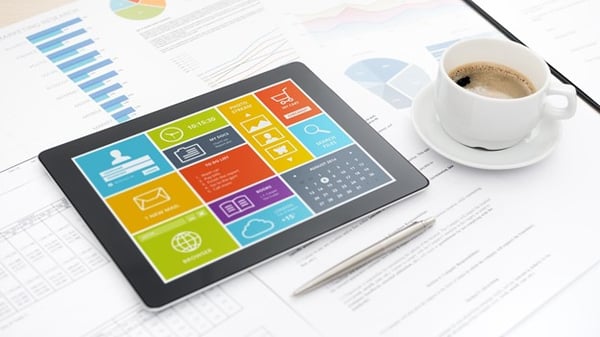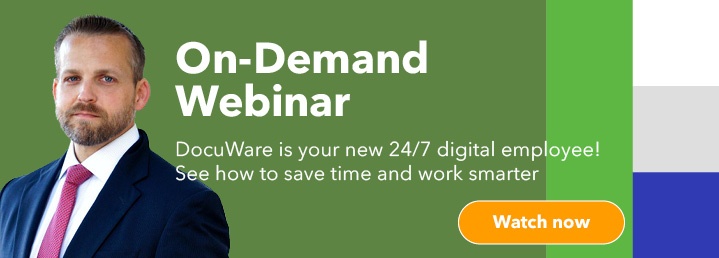According to a study from Deloitte, around 80% of small businesses don't take full advantage of technology. While midsize and larger organizations — which often have in-house technical resources — tend to adopt solutions at a faster rate, there's plenty of room for improvement in those businesses too. And ease of use plays an enormous role in determining whether businesses can successfully integrate a document management solution (DMS) and other technology.
Choosing user-friendly software for your organization helps ensure increased buy-in and adoption. Tools that don't frustrate your staff — or make them think their job is being made harder — are much easier to implement. Learn more about what makes software meet these criteria below.
What does user-friendliness mean for software?
User-friendly software is exactly what it sounds like: it's a technical solution that is easy for all (or at least most) people to use to get their jobs done.
This doesn't mean the software isn’t complex and feature-rich behind the scenes or that anyone can step up to a computer and operate it correctly. For example, even easy-to-use accounting software may seem daunting to a layperson who has no idea what general ledgers are.
The goal of choosing a software solution that even non-technical people find accessible is to select an option that best meets the needs of your organization and teams while making the individual tasks much easier than they would be without it.
What are the qualities you should seek out?
Obviously, the needs of your teams and business processes dictate, to some degree, what user-friendly means for your organization. But you can start with the list below to evaluate whether a potential document management software or any other solution is right for your company.
1. Easy and simple installation and updates.jpg?width=600&name=iStock-1300934314%20(1).jpg)
Ease of use starts before anyone in your organization even uses a software program. If the technology takes hours to install on each user's machine or is difficult to integrate into existing processes, that's not what you’re looking for. One of the advantages of using cloud-based rather than on-premises software is that users access information from the cloud and no local installation is needed.
Tech implementations do take work, and you should be prepared to create a project team that develops an overall plan and engages subject matter experts from the departments going digital. As well as to set aside the time to train staff to use the system properly. But weigh how much upfront work goes into the process — and whether future releases will be seamless or require internal IT resources. These are factors that can help you choose between solutions.
2. A user-friendly interface that's visually appealing
User-friendly software doesn't give people headaches if they look at it for too long. That means it has a clean interface without unsettling colors and design elements. Almost no one wants to stare at a hot pink screen with a blue font. And while that's an extreme example, it demonstrates the point that all the details matter.
Look for software that:
- Has a user interface design that displays individual tasks or one task type at a time. (If a user can pick every option the software offers from one screen, that's too much.)
- Lets you declutter with role-based and user-based customization
- Offers an interface that is visually appealing to a wide range of users
3. Intuitive operation that's familiar to the user, including straightforward navigation
.jpg?width=600&name=iStock-1175911679%20(2).jpg)
If your staff is used to working in a Windows environment where tasks are based primarily on clicks and drag-and-drop, they're going to falter if you force them to use a system based solely on keystrokes. Choose software that presents an environment that's familiar to your workforce.
Pay attention to navigation too. Most people are used to top-level header menus or hamburger menus. Make sure the menus in the solution you choose are set up in a logical way; someone familiar with your processes but not familiar with the navigation should be able to successfully figure out where to click to get where they need to go with little trial and error.
4. Operation that's efficient%20(1).jpg?width=600&name=iStock-1208625534%20(1)%20(1).jpg)
A significant increase in efficiency is a must-have for software to be considered user-friendly. Team members shouldn't have to click 12 times to complete a routine task when software could easily be set up to support a two-click process for that workflow. Some factors that drive efficient operation include:
- Opportunity for office automation. Tedious, repetitive and simple tasks can be automated to remove the burden from staff and let them focus on more high-value tasks.
- Flexible integration capability. Look for both integration capability that doesn’t depend on internal IT support and the availability of more sophisticated tools like a REST application program interface (API).
- Smart workflows. Review the software’s capabilities to ensure it can accommodate the workflows you want to automate. If one task requires a piece of information and you have to close that task to get to the data in another area of the software, that's not efficient.
5. Doesn't require additional software resources (but also doesn't rule them out)
User-friendly software gets its job done without requiring you to purchase and/or implement a third-party solution on the side. Look for software options that stand alone.
But make sure the solution you purchase doesn't restrict third-party integrations. As your business grows and evolves, you may need those options to support new requirements.
The software should also integrate with your existing technology infrastructure including your ERP and accounting and HR-specific software.
6. Has security that meets or exceeds industry standards.jpg?width=600&name=iStock-1219629042%20(1).jpg)
No one is immune to security issues; more than 40% of cyberattacks target small businesses. And if a breach does occur, it can take months on average for it to be discovered!
No software should get a stamp of approval without robust security. Discuss security needs and requirements with vendors before you purchase software. Some of the best options are those that provide ongoing security updates to keep your business processes and data as safe as possible. Cloud-based options should include the use of the Advanced Encryption Standard (AES), strict data separation and real-time security analysis.
7. Comes with extensive support options
Finally, the range of support options a solution has can make or break a software's grade for user-friendliness. In addition to comprehensive help files within the software and the ability to reach out and connect with an expert support team, you should look for additional resources that will help your teams make the most of their solution.
Look for software that offers:
- A blog or a newsletter, educational videos and a searchable knowledge base. When you can read articles about specific features and benefits in a blog or newsletter — or watch videos on how to use them — you can ensure your teams are optimizing productivity and efficiency with the solution. A searchable knowledge base will provide answers to commonly asked questions.
- Customer forums. These online discussion boards enable you to become part of a user community and collaborate with your peers at other companies.
- Automatic updates. If you opt for cloud-based software, automatic updates ensure the version that you’re working with is always the one that's supported and most secure.
- Support contact options that work for you. Vendors may provide support via phone, chat, email or in person. Look for software solutions backed by the type of support that works best for you and your teams.
What makes DMS software user-friendly?

Everything that applies to other types of software also enhances your experience with DMS software, so consider the above traits when choosing document management solutions. Some other features to look for include:
- Scalable cloud-based storage and software that supports remote teams
- Highly usable tools and seamless integration.
- Ability to integrate e-signatures to eliminate the need for hard copies, scanning and waiting for signed documents to be mailed or emailed
- Easier compliance because of the correct handling of audit-related documents, protection of confidential employee information, easily accessible proof that compliance standards have been met and automated retention schedules
- Intelligent and automatic indexing, classification capabilities that increase findability and version control
Frequently asked questions about user-friendly software
Why is it so important for software to be user-friendly?
It supports greater adoption from team members. It also enhances efficiency and productivity helping staff complete tasks faster and with less frustration and fatigue. The best software can even help staff come up with better processes or scale existing ones.
What are some examples of user-friendly software?
Microsoft's word-processing software is a great example. Anyone can open it up and start typing a document, and anyone familiar with the concept of word processors can easily create basic formatting and use the integrated spell checker.
Google Docs offers a cloud-based word processor that was developed after Microsoft's. Because so many people were familiar with the Word concept, Google Docs works in much the same way to promote user-friendliness through familiarity.
DocuWare takes the same approach when developing solutions for various industries. We think about what's familiar and easy for the user and expand on that to deliver robust easy-to-use software. The product management team focuses on creating an outstanding, intuitive and satisfying user experience. It consists of product managers, user interface designers and usability managers who each have a role in ensuring that our product is easy to use and can be configured to meet the needs of any organization. We also have a Product Tester program, so customers can give feedback that is incorporated during product development.
How can user-friendly software impact your business?
The advantages you’ll gain include:
- Higher adoption rates. Users are more likely to be willing to use new software if it's not hard to learn and work with.
- More productivity. Efficient software lets staff get more done in the same amount of time.
- Happier staff. Teams that use digital tools to help them get more done and meet their goals tend to have higher morale. They’re also freed up to use their talents, expertise and customer service skills which contributes to job satisfaction.
- Ability to keep up with the pace of modern business. Streamlined processes made up of simple, meaningful steps maximize your company’s ability to react to changing economic conditions and stay competitive.
- Cost savings. Software that works alongside teams to support better processes that saves time and money in the long term.
To find out more about DocuWare Cloud’s user-friendly design and comprehensive capabilities: Request a demo.

.jpg)


.jpg?width=600&name=iStock-594909518%20(1).jpg)

